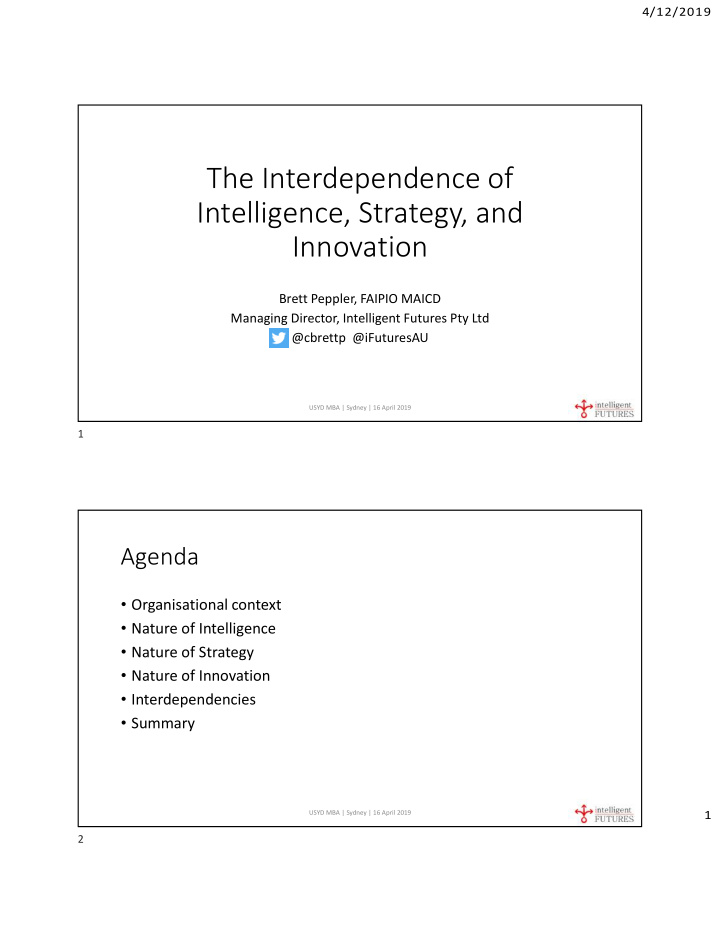



4/12/2019 The Interdependence of Intelligence, Strategy, and Innovation Brett Peppler, FAIPIO MAICD Managing Director, Intelligent Futures Pty Ltd @cbrettp @iFuturesAU USYD MBA | Sydney | 16 April 2019 1 Agenda • Organisational context • Nature of Intelligence • Nature of Strategy • Nature of Innovation • Interdependencies • Summary USYD MBA | Sydney | 16 April 2019 1 2
4/12/2019 External Environment • Rapid progress in digitalisation and changing customer behaviour continue to transform the competitive landscape. • Regulation and measures from industry regulators have influenced the offering of products and services. • Other traditional barriers to entry to the financial services sector - such as scale - are eroding. USYD MBA | Sydney | 16 April 2019 3 Internal Environment • A disconnected perspective across an organization – often arising from tensions between managing H1, H2 and H3 horizons concurrently - may lead us to see different problems and work at cross purposes. USYD MBA | Sydney | 16 April 2019 2 4
4/12/2019 Dilemmas of Incumbency • Accumulating legacy technical debt • Constrained strategic agility • Eroding advantages of traditional scale • Declining utility of industry- specific mindsets and assumptions • Bias for action in the short-term USYD MBA | Sydney | 16 April 2019 5 Nature of Intelligence • Intelligence is an evocative term – and not well understood beyond the national security realm - but is generally considered to mean an organisational capability able to generate value-added insights that confer an actionable advantage to a business client, especially in terms of decision support. USYD MBA | Sydney | 16 April 2019 3 6
4/12/2019 Detect Signals of Change • A weak signal is a seemingly random or disconnected piece of information that at first appears to be background noise but can be recognized as part of a significant pattern by viewing it through a different frame or connecting it with other pieces of information. Intelligence-Driven Business | Sydney | 20 February 2019 7 Create Optionality • A strategic option is a position that we can take to generate insights into the nature and dynamics of change. • These insights inform a possible action that we might choose, and would be in a position to execute, at an opportune moment in the future. USYD MBA | Sydney | 16 April 2019 4 8
4/12/2019 Manage Strategic Options USYD MBA | Sydney | 16 April 2019 9 Intelligence Challenges • Deeply understanding the ‘space’ and ‘time’ dimensions of the organisation to find critical concerns (WHAT to communicate) and information leverage points (WHERE, WHEN, and HOW to communicate). Intelligence-Driven Business | Sydney | 20 February 2019 5 10
4/12/2019 Nature of Strategy • Strategy is a systemic interpretive framework for understanding our position with respect to a complex, fast changing, uncertain/unknown context not • [long term] planning for setting of [financial] objectives and allocation of resources USYD MBA | Sydney | 16 April 2019 11 Incoherence USYD MBA | Sydney | 16 April 2019 6 12
4/12/2019 Example - Incoherence USYD MBA | Sydney | 16 April 2019 13 Choice - Where to Play? USYD MBA | Sydney | 16 April 2019 7 14
4/12/2019 Choice - How to Win? USYD MBA | Sydney | 16 April 2019 15 Strategy Challenges • Pre-occupation with business planning • Resource constraints impose trade-offs in strategic settings • Strategy adapts to the real world • Residual risk in strategic decision-making USYD MBA | Sydney | 16 April 2019 8 16
4/12/2019 Nature of Innovation • ‘Invention,’ ‘novelty,’ and ‘change’ describe the nature of innovation, but these characteristics continue to evolve, challenging the classical scope of innovation - centred on technological innovation - to include a variety of services, business model, and social innovation. USYD MBA | Sydney | 16 April 2019 17 Spectrum of Innovation • Horizon 1 initiatives provide continuous innovation to enhance a company’s existing business model and core capabilities in the short-term. • Horizon 2 initiatives extend a company’s existing business model and core capabilities to new customers, markets, or targets. • Horizon 3 initiatives renew capabilities and business models to take advantage of or respond to disruptive opportunities or to counter disruption. USYD MBA | Sydney | 16 April 2019 9 18
4/12/2019 Innovation Challenges • Alignment with the organisation’s strategic objectives • Overcoming organisational inertia • Securing human and capital resources for innovation • Balancing investment across the spectrum of innovation USYD MBA | Sydney | 16 April 2019 19 Model of Interdependencies Choice of options expressed in strategic settings defining ‘where to play’ and ‘how to win’ in those (Intelligence + Strategy) – Innovation = spaces - which leads to risk Limited controls in place to mitigate Strategy (Strategy + Innovation) – Intelligence = residual risk in strategic settings Idea-driven innovation vice needs-driven Capability to discriminate Principal control available to between threats and the organisation to mitigate opportunities to offer the risks arising from strategic organisation appropriate settings Intelligence Innovation optionality (Innovation + Intelligence) – Strategy = Innovation is poorly aligned with strategic objectives USYD MBA | Sydney | 16 April 2019 10 20
4/12/2019 Summary • Intelligence may not provide a precise answer but disciplined judgments drawn from the best available information helps us better understand the problem, and reduces the risk in decision making. • Strategy is the activity by which human systems - through deliberate choice - establish and manage settings to achieve a coherent relationship between themselves and their environment. • Innovation is the principal control available to the organisation to mitigate risks arising from these strategic settings. • Each of these components is evocative and necessary but not sufficient for resilience and competitiveness in the longer term. USYD MBA | Sydney | 16 April 2019 21 11
Recommend
More recommend